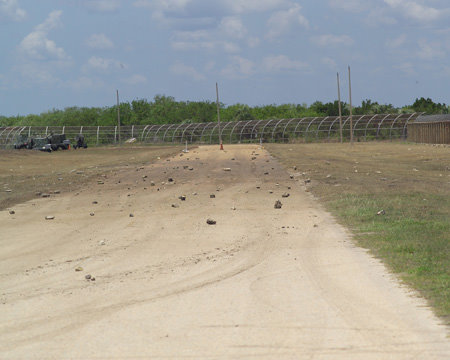Debris falls into the water following Discovery’s launch on Saturday. Images from CBS Space Place.
The launchpad at Kennedy Space Center was damaged during Saturday’s space shuttle launch. Pictures taken during Discovery’s launch show debris raining down into the waterway just behind launchpad 39A. Additional images show debris that appears to be broken concrete littering a nearby road as well as damaged and buckled concrete on one side of the launchpad. CBS News’ Bill Harwood reported that the damage to the pad occured on the north side of the “flame trench” wall. The trench is used to divert exhaust from the shuttle’s solid rocket boosters.
The damage is “unusual,” Harwood quoted NASA spokesman Bill Johnson, who verified the damage was serious and tomorrow (Monday) a full report on the incident will be issued. Harwood also reported that a NASA manager said part of the pad’s base was repaired following a previous launch, but possibly something was either missed or not repaired correctly.

The debris appears to come from the lauchpad itself, and not the shuttle. And whether any of the debris hit the shuttle is currently unknown. The astronauts on board Discovery have not yet been able to conduct the usual inspection of the shuttle nose cap and wing leading edge panels because the 50-foot-long boom equipped with laser scanners and high-resolution cameras was unable to fit into the shuttle’s payload bay due to the large size of the Japanese Kibo laboratory that Discovery is bringing to the International Space Station. The last shuttle crew left the orbiter boom sensor system at the ISS, and the crew of Discovery will retrieve it while docked to the station. ISS crew members will take high resolution pictures of the shuttle as it approaches the station on Monday. Docking is scheduled about 2 pm EDT.
Both launchpads at KSC, 39A and 39B were originally built for the Apollo spacecraft/Saturn rockets and were modified for the space shuttles. During launches the pads must withstand both high heat and extreme pressure.
Original News Source: CBS Space Place



On the bright side, the toilet will get fixed? :\
Seems to me that this type of damage should be expected as the norm, or at least not be unusual considering the massive amounts of force exerted when trying to get something so large and heavy into orbit.
I heard about this via Damaris B. Sarria’s blog – http://damarisbsarria.blogspot.com/ – a NASA insider of sorts who’s just applied for the Astronaut training programme.
If I want to speculate – and I do mean speculate – I’m guessing that there was liquid water somewhere it wasn’t supposed to be. Subject that to the massive blast of intense heat from the engines, and you could have explosive expansion of steam. (I used to work in a steel factory, and if a blob of molten metal landed in a puddle, it went off like a bomb, shaking the whole factory.)
If it is a fresh repair the concrete used may not have set up properly yet. It can take a considerable amount of time for concrete to set fully and as mentioned before if there was still moisture within the recently repaired section, it is very likely that it was superheated and subsequently was blown apart. I say it’s the cost of doing business.
This best not delay the Hubble service launch…
in the same vein of pure speculation..
I used to do a lot of firing of clay pieces – sometimes we’d go over 2,000 degrees, which may be a similar temperature range, tho we did it a lot more gradually. Two things would often be destructive:
one was moisture pockets as previously mentioned, altho those usually just showed up as masses that contracted at different rates and eventually cracked and separated from each other.
The things that would really be explosive – usually taking out other people’s pieces with them – were certain kinds of little rocks that had snuck through our filtration process, because they were a lot denser than the clay and didn’t shrink with the heat as the surrounding clay did, creating a lot of tension that would be released explosively. certain kinds of rock in concrete might have similar properties.
Considering the rapidity of the temp change in a rocket launch, steam is still the more probable of the two theories, but either is plausible.